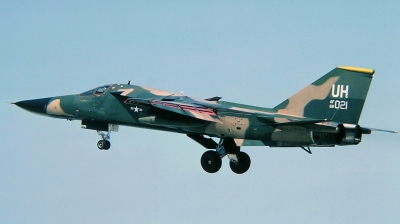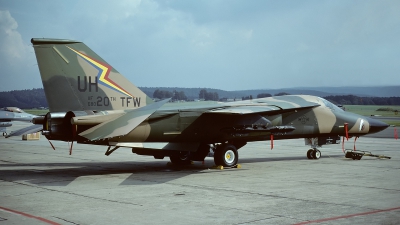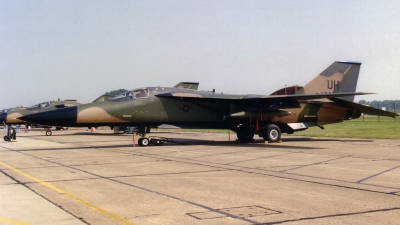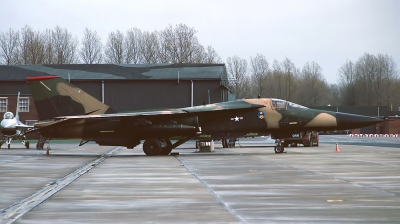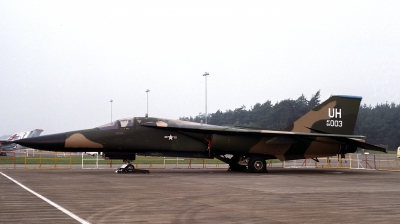General Dynamics F-111E Aardvark Aircraft Data
The versatile "swing wing" F-111 entered the USAF inventory in 1967. The F-111’s wings are straight for takeoff, landing or slow speed flight, but by sweeping its wings rearward, in can exceed twice the speed of sound (Mach 2). In 1960 the Department of Defense combined the USAF’s requirement for a fighter-bomber with a Navy need for an air superiority fighter, though the Navy eventually cancelled its program. In all, 566 F-111s of all series were built; 94 of them were production F-111Es.
The F-111 was a long-range, all-weather strike aircraft capable of navigating at low level to reach targets deep in enemy territory and to deliver ordinance on the target. Primarily a bomber, the F-111 featured a sweep wing varying between 16 and 72.5 degrees, with side-by-side seating for a pilot and weapons systems officer.
The Warner Robins Air Logistics Center was responsible for all program and logistics support for the F-111s avionics, communications, navigation and targeting systems.
The F-111E model had modified air intakes to improve the engine's performance at speeds above Mach 2.2. Most F-111Es served with the 20th Fighter Wing, Royal Air Force Station Upper Heyford, England, to support NATO. F-111Es were deployed to Incirlik Air Base, Turkey, and were used in Operation Desert Storm. In the early morning of Jan. 17, 1991, the F-111 went into combat again in the initial bombing raids of Operation Desert Storm.
The F-111E was a simplified, interim variant ordered after the F-111D was delayed. The E-model was first ordered in 1968 and delivered from 1969-71. It achieved initial operational capability in 1969. The variant's first flight occurred on 20 August 1969. The F-111E used the Triple Plow II intakes, but retained the F-111A's TF30-P-3 engines and Mark I avionics. The weapon stores management system was improved and other small changes made.
Some F-111Es received improved TF30-P-109 engines in the early 1990s. All F-111Es were retired to AMARC by 1995.
The F-111 was a long-range, all-weather strike aircraft capable of navigating at low level to reach targets deep in enemy territory and to deliver ordinance on the target. Primarily a bomber, the F-111 featured a sweep wing varying between 16 and 72.5 degrees, with side-by-side seating for a pilot and weapons systems officer.
The Warner Robins Air Logistics Center was responsible for all program and logistics support for the F-111s avionics, communications, navigation and targeting systems.
The F-111E model had modified air intakes to improve the engine's performance at speeds above Mach 2.2. Most F-111Es served with the 20th Fighter Wing, Royal Air Force Station Upper Heyford, England, to support NATO. F-111Es were deployed to Incirlik Air Base, Turkey, and were used in Operation Desert Storm. In the early morning of Jan. 17, 1991, the F-111 went into combat again in the initial bombing raids of Operation Desert Storm.
The F-111E was a simplified, interim variant ordered after the F-111D was delayed. The E-model was first ordered in 1968 and delivered from 1969-71. It achieved initial operational capability in 1969. The variant's first flight occurred on 20 August 1969. The F-111E used the Triple Plow II intakes, but retained the F-111A's TF30-P-3 engines and Mark I avionics. The weapon stores management system was improved and other small changes made.
Some F-111Es received improved TF30-P-109 engines in the early 1990s. All F-111Es were retired to AMARC by 1995.
- Country of Origin: United States
- First Flight: 1969
- Initial Service Date:
- No. Built: 94
- No. In Service: 0
- No. of Hardpoints: 9
- Crew: 2
Power:
2 × Pratt & Whitney TF30-P-100 turbofans Dry thrust: each at 17,900 lbf
Weapons:
Guns: 1× 20 mm (0.787 in) M61A1 Vulcan 6-barreled Gatling cannon in weapons bay seldom fitted
Missiles:
AGM-69 SRAM thermonuclear air-to-surface missile (FB-111A only)
AGM-130 stand-off bomb
Bombs:
Free-fall general-purpose bombs including Mk 82 (500 lb/227 kg), Mk 83 (1,000 lb/454 kg), Mk 84 (2,000 lb/907 kg), and Mk 117 (750 lb/340 kg)
Cluster bombs
BLU-109 (2,000 lb/907 kg) hardened penetration bomb
Paveway laser-guided bombs, including 2,000 lb (907 kg) GBU-10, 500 lb (227 kg) GBU-12, and 4,800 lb (2,200 kg) GBU-28 penetration bomb
BLU-107 Durandal runway-cratering bomb
GBU-15 electro-optical bomb
B61 or B43 nuclear bombs
Missiles:
AGM-69 SRAM thermonuclear air-to-surface missile (FB-111A only)
AGM-130 stand-off bomb
Bombs:
Free-fall general-purpose bombs including Mk 82 (500 lb/227 kg), Mk 83 (1,000 lb/454 kg), Mk 84 (2,000 lb/907 kg), and Mk 117 (750 lb/340 kg)
Cluster bombs
BLU-109 (2,000 lb/907 kg) hardened penetration bomb
Paveway laser-guided bombs, including 2,000 lb (907 kg) GBU-10, 500 lb (227 kg) GBU-12, and 4,800 lb (2,200 kg) GBU-28 penetration bomb
BLU-107 Durandal runway-cratering bomb
GBU-15 electro-optical bomb
B61 or B43 nuclear bombs
Dimensions:
| Length: | 73 ft 6 in. |
| Wing Span: | 63 ft in. |
| Wing Area: | 657.4 sq.ft |
| Height: | 17.13 in. |
| Empty Weight: | 47,200 lbs |
| Max. Weight: | 100,000 lbs |
| Max. Ordnance Load: | 31,000 lbs |
Performance:
| Max. Speed: | 1,650 mph |
| Service Ceiling: | 66,000 ft. |
| Normal Range: | 3,210 nm |
| Max. Range: | 3,700 nm |
Operators:
United StatesAustralia
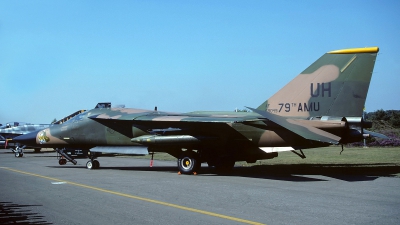
 Random great photos of the General Dynamics F-111E Aardvark:
Random great photos of the General Dynamics F-111E Aardvark:
